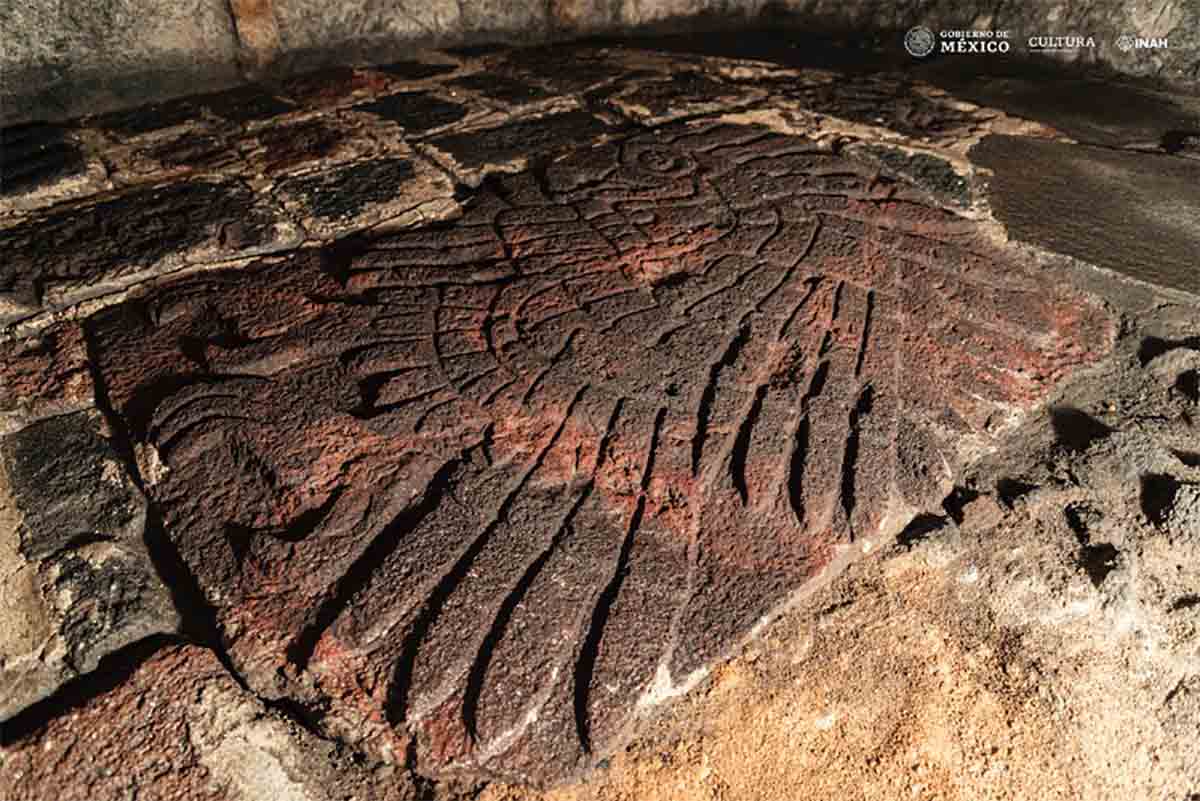Giant Obsidian Golden Eagle Surfaces in Mexico
The Aztec’s Hueteocalli, otherwise known as the Templo Mayor (which translates into “Great Temple”) stood at the center of Tenochtitlan (Mexico City), the capital city of the Aztec world in Mexico. With its twin temples dedicated to the war god Huitzilopochtli and to the rain god Tlaloc, archaeologists from the Templo Mayor Project (PTM) of the National Institute of Anthropology and History (INAH) have discovered a sculptured stone displaying a golden eagle.
It is at the foot of this architectural wonder of the Aztec religious world in modern-day Mexico City, on the central axis of the temple dedicated to Huitzilopochtl and the monumental sculpture of the goddess Coyolxauhqui, that archaeologists have unearthed the giant obsidian eagle. And this is no ordinary carved eagle, for it represents the largest of its type ever discovered.

The golden eagle bas-relief was discovered during excavations at the Templo Mayor in the center of Mexico City. (Bill Perry / Adobe Stock)
Measuring up the Golden Eagle
Dating to the rule of Motecuhzoma Ilhuicamina, between 1440 and 1469 AD, Mexico’s Secretary of Culture, Alejandra Frausto Guerrero, said the carved itzcuauhtli (obsidian eagle) was discovered in February 2020. The representation of a golden eagle ( Aquila chrysaetos canadensis) measures 1.06 meters (3.47 ft) long and 0.7 meters (2.26 ft) wide. The ancient bas-relief is “the largest in a set of 67 similar elements discovered in the Templo Mayor.
- Giant Face of Ucanha: Giant Sculpted Mayan Mask Found in Mexico
- 2000-Year-Old Monolith Reveals Hidden Symbols in Amazon
- Why Are There Carvings of Women Flashing Their Genitals on Churches Across Europe?
The stone was discovered near the circular Cuauhxicalco, or “place of the eagle's gourd,” where 16th century accounts say the Tenochca rulers were ritually cremated. Lead archaeologist Professor Leonardo López Luján says the eagle was carved on “red tezontle,” which is a porous, highly oxidized, volcanic rock used extensively in construction in both ancient and modern Mexico.

The golden eagle bas-relief, measuring 1.06 meters (3.47 ft) long and 0.7 meters (2.26 ft) wide, was discovered on the south side of the Templo Mayor in Mexico City (Mirsa Islas / INAH)
The Way of the Eagle and the Jaguar
Dr. López Luján added that the plaza floor in the Templo Mayor had been covered since pre-Hispanic time and that it is unique because its bas-reliefs “alluding to the dual conception of the building.” The eagle was discovered on the south side of the temple which is associated with the mythical birth cycle of Huitzilopochtli; while to the north, the bas-reliefs are associated with Tláloc, “the water cycle and the regeneration of corn.” Dr. López Luján’s team originally believed the floor was built by the government of Ahuítzotl between 1486 and 1502 AD, but now it is thought to date to the government of Motecuhzoma I in the 1440s.
Aztec boys were taught about weaponry and warfare until the age of 17 when the best students progressed to become “eagle warriors” and earned nobility in Aztec society. However, to achieve adult status young men had to capture their first prisoner and after they had captured 20 a young man was eligible to become either a jaguar or eagle warrior. Either way, both paths meant a life spent in constant battle to capture prisoners for sacrificing to the gods.

The Mexican coat of arms depicts a golden eagle perched on a prickly pear cactus devouring a rattlesnake. (Public domain)
The Golden Eagle in Mexican Society, and Beyond
The golden eagle exists today in the Mexican coat of arms, that depicts the bird of prey perched on a prickly pear cactus devouring a rattlesnake. This image reflects the ancient Aztec legend that their capital city was located where an eagle was seen eating a snake on top of a lake. For the people of Tenochtitlan the eagle symbol had strong and positive religious connotations, but for the European invaders it was the serpent from the Garden of Eden representing the sinister voice of temptation.
The eagle was not only symbolic in ancient Mexico but across the entirety of South America from Brazil in the east to Ecuador in the west, and Peru in the south: where it was incorporated in mythology with the condor. According to the the Pachamama Alliance “The Eagle and the Condor” is an ancient Inca prophecy that speaks of humans splitting and following two paths, that of the eagle or the condor. The path of the condor is the path of heart, of intuition, and as such it represents feminine universal aspects. On the other hand, the path of the eagle is the path of the mind: the masculine way.
The prophecy of the eagle and condor says that beginning in the 1490s a 500-year cycle would begin in which the Eagle people would become so powerful that they would nearly drive the Condor people out of existence. This prophecy is believed to have become manifest in the subsequent Spanish conquest of South America, and according to most indigenous communities in South America today is still unfolding in the shape of old giants ripping apart their indigenous lands for liquid gold.
Top image: The giant bas-relief of a golden eagle has been discovered during excavations at the Templo Mayor in Mexico City. Source: Mirsa Islas / INAH
By Ashley Cowie




















Comments
The craftsmanship is stunning. I hope this finds its way into a museum, where the public can enjoy it forever.